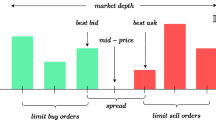Abstract
The paper proposes a new approach — The decomposition-based vector autoregressive (DVAR) model to scrutinize the predictability of the UK stock market. Empirical studies performed on the monthly British FTSE100 index over 1984–2012 confirm that the DVAR model does provide informative forecasts for both in-sample and out-of-sample forecasts. Trading strategies based on the DVAR forecasts can significantly beat the simple buy-and-hold, which demonstrates the valuable information provided by technical analysis in the UK stock market.
Similar content being viewed by others
References
Fama E F, Efficient capital markets: A review of theory and empirical work, Journal of Finance, 1970 25: 383–417.
Cochrane J H, New facts in finance, Economic Perspectives, 1999, 23: 36–58.
Rozeff M, Dividend yields are equity risk premiums, Journal of Portfolio Management, 1984, 11: 68–75.
Campbell J Y and Shiller R J, The dividend-price ratio and expectations of future dividends and discount factors, Review of Financial Studies, 1988, 1: 195–228.
Fama E F and French K R, Dividend yields and expected stock returns, Journal of Financial Economics, 1988, 22: 3–25.
Hodrick R J, Dividend yields and expected stock returns: Alternative procedures for inference and measurement, Review of Financial Studies, 1992, 5: 257–286.
Lewellen J, Predicting returns with financial ratios, Journal of Financial Economics, 2004, 74: 209–235.
Campbell J Y and Shiller R J, Stock prices, earnings, and expected dividends, Journal of Finance, 1988b, 43: 661–676.
Campbell J Y and Shiller R J, Valuation ratios and the long-run stock market outlook, Journal of Portfolio Management, 1998, 24: 11–26.
Lamont O, Earnings and expected returns, Journal of Finance, 1998, 53: 1563–1587.
Kothari S P and Shanken J, Book-to-market, dividend yield, and expected market returns: A time series analysis, Journal of Financial Economics, 1997, 44: 169–203.
Pontiff J and Schall L D, Book-to-market ratios as predictors of market returns, Journal of Financial Economics, 1998, 49: 141–160.
Ang A and Bekaert G, Stock return predictability: Is it there?, Review of Financial Studies, 2007, 20: 651–707.
Keim D B and Stambaugh R F, Predicting returns in the stock and bond markets, Journal of Financial Economics, 1986, 17: 357–390.
Campbell J Y, Stock returns and the term structure, Journal of Financial Economics, 1987, 18: 373–399.
Fama E F and French K R, Business conditions and expected returns on stocks and bonds, Journal of Financial Economics, 1989, 25: 23–49.
Lettau M and Ludvigson S, Consumption, aggregate wealth, and expected stock returns, Journal of Finance, 2001, 56: 815–849.
Rey D, Stock market predictability: Is it there? A critical review, 2004, http://citeseerx.ist.psu.edu/viewdoc/summary?doi=10.1.1.137.7294.
Clare A D, Thomas S H, and Wickens M R, Is the gilt-equity yield ratio useful for predicting UK stock return?, Economic Journal, 1994, 104: 303–315.
Black A and Fraser P, UK stock return: Predictability and business conditions, The Manchester School Supplement, 1995, 85–102.
Pesaran M H and Timmermann A, A recursive modeling approach to predicting UK stock returns, Economic Journal, 2000, 110: 159–191.
McMillan D G, Nonlinear predictability of short-run deviations in UK stock market returns, Economic Letters, 2004, 84: 149–154.
Xie H B and Wang S Y, A new approach to modeling financial markets, Journal of Systems Science and Complexity, 2013, 26(3) 432–440.
Parkinson M, The extreme value method for estimating the variance of the rate of return, Journal of Business, 1980, 53: 61–65.
Nison S, Japanese Candlestick Charting Techniques, New York Institute of Finance, New York, 1991.
Morris G, Candlestick Charting Explained, New York, McGrawHill, 1992.
Campbell J Y and Thompson S B, Predicting excess stock returns out-of-sample: Can anything beat the historical average? Review of Financial Studies, 2008, 21(4) 169–203.
Welch I and Goyal A, A comprehensive look at the empirical performance of equity premium prediction, Review of Financial Studies, 2008, 21(4) 169–203.
Author information
Authors and Affiliations
Additional information
This research is supported by Social Science Foundation of Ministry of Education of China under Grant No. 12YJC790001, National Social Science Foundation of China under Grant No. 12CJY117, the National Natural Science Foundation of China under Grant Nos. 71003057 and 71373262, and the Program for Innovative Research Team and “211” Program in UIBE.
This paper was recommended for publication by Editor WANG Shouyang.
Rights and permissions
About this article
Cite this article
Xie, H., Bian, J., Wang, M. et al. Is technical analysis informative in UK stock market? Evidence from decomposition-based vector autoregressive (DVAR) model. J Syst Sci Complex 27, 144–156 (2014). https://doi.org/10.1007/s11424-014-3280-9
Received:
Revised:
Published:
Issue Date:
DOI: https://doi.org/10.1007/s11424-014-3280-9




